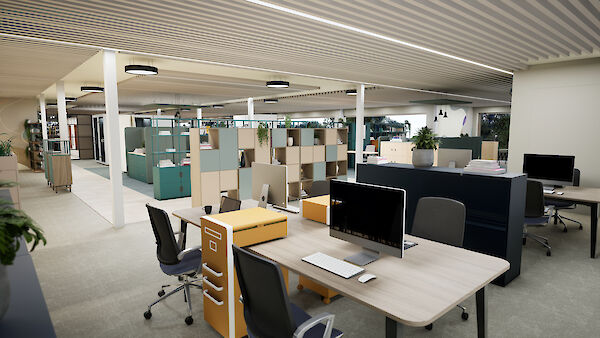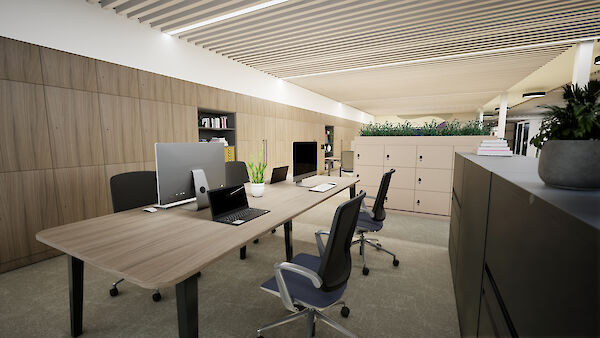
Ensuring your storage solutions work for you is one of the most fundamental things to think about when designing your workspace – and it can be beautiful, as well as practical.
No matter what size or shape space you’re working with, there are ways to integrate storage to make it work as hard as possible – serving multiple purposes, building on your brand, and enhancing your overall office aesthetic.
We sat down with our Creative Director, Jeanine Goddard, to find out how best to approach storage when planning, redesigning, or zoning a workplace. Here are her top tips.
First, think about the people
Every business and every role has different storage needs that can vary greatly, based on both your business function, and the space you’re working in. But one thing is a constant, making it an easy one to start with, because there’s no question about whether you’ll need it or not: personal storage.
Every single one of your colleagues will need personal storage space in some shape or form. Think about who works in your office – are they there every day, or do they fly in every fortnight? What luggage will they have with them? If they’ve come far, will they need space to stow outdoor clothing and layers? Do you need to think about bike racks, or cubbies to store a helmet and high-vis jacket?
Giving people adequate space to store things has lots of benefits. Firstly, it can help keep your welcome space tidy and make your colleagues feel comfortable. It also helps cultivate a sense of belonging and organisation, and, importantly, it dramatically reduces clutter – which, in turn, can boost productivity.

Next, consider your business
Once you’ve identified the basic personal storage solutions you think you’ll need, it’s time to start thinking bigger. As a business, what items do you need to store day to day?
If you’re a digital-led company, you might not need space for reams of paper files – but you might have things like samples or brochures, marketing materials or stock. On the other hand, if your industry still works in wet ink, you’ll probably need space for paper bundles, files, and documents. You might find it’s a mix of both – but it’s important to be realistic about the types of business items you’ll need to store in your workspace.
Then, work out how secure you need your storage to be
The last piece in the puzzle, before getting onto designing the space, is to think about security. What are you storing, and how safe and secure do you need it to be? Whether your items are high value financially, or contain confidential information, you’ll need to make sure your storage solution is adapted accordingly.
Think about what’s already in place, and what an ideal solution would look like. Does your building come with a certain security system? Do you access areas via a lanyard, or with a fingerprint? Are you using codes and keypads, or restricted access on an individual level?
There are lots of ways to incorporate different locking and security systems into your storage, which is why it’s an important part of planning if you want to integrate your storage seamlessly, and make sure it’s truly fit for purpose.

Finally, get creative – think outside the storage box
Once you’ve thought about personal and business storage requirements, and taken any security concerns into consideration, you’re ready to start planning your space with storage in mind.
Here’s where you can get creative, and really think outside the box. If you want to make storage work for you, think about options that create flexibility.
Could you turn your under-desk caddy that’s fit for a handbag or a spare pair of running shoes into an impromptu meeting space? You could store some seat-pads inside, ready to store on top. Could a three-high storage unit, used for binders and files, also be used in the same way as a standing height table or an area for someone to lean for a quick chat?
Think about the aesthetic and practical benefits that storage can bring, too. If you’ve got units that aren’t too high, you could put planters on top and use it as a room divider or zoning device, so that it has a double purpose.
Integrating plants into storage is a fantastic solution, especially in more open plan spaces. As well as screening colleagues from intrusion and adding to focus, if they’re used in long runs or open shelving units, they can be mood-boosting and relaxing, as well as good for the environment, air quality, and acoustics.
If you’re thinking about lockers, consider a range of sizes – some full sized for coats or suitcases, and others for smaller, more personal items.
Don’t forget that you can break storage units up, too – physically, by adding open units like pass-throughs or bookshelves, or even complete doors if you’re working with metal units, and visually, too, by using different colours and tones.
Finally, remember that flexibility is key: your storage requirements might change as you grow, so design with this in mind.